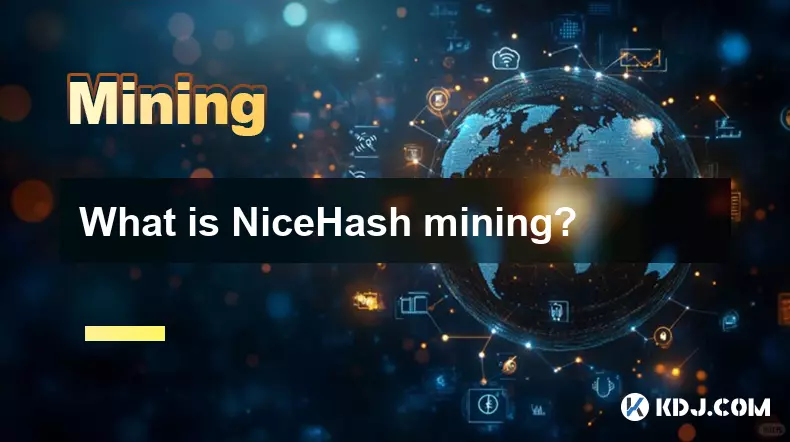-
 bitcoin
bitcoin $105968.894684 USD
4.17% -
 ethereum
ethereum $3639.320047 USD
7.62% -
 tether
tether $1.000339 USD
0.06% -
 xrp
xrp $2.407774 USD
5.96% -
 bnb
bnb $1011.704193 USD
2.28% -
 solana
solana $166.942754 USD
6.37% -
 usd-coin
usd-coin $1.000143 USD
0.03% -
 tron
tron $0.291515 USD
0.25% -
 dogecoin
dogecoin $0.181682 USD
4.06% -
 cardano
cardano $0.585450 USD
4.54% -
 hyperliquid
hyperliquid $42.099968 USD
5.20% -
 chainlink
chainlink $16.160745 USD
5.45% -
 zcash
zcash $645.269648 USD
12.96% -
 bitcoin-cash
bitcoin-cash $507.430338 USD
2.80% -
 stellar
stellar $0.290357 USD
3.69%
Understanding the basics of cryptocurrency mining.
Cryptocurrency mining validates transactions and creates new coins using powerful computers to solve complex puzzles, with miners rewarded in crypto.
Nov 05, 2025 at 10:54 pm

What Is Cryptocurrency Mining?
1. Cryptocurrency mining is the process by which new digital coins are introduced into circulation and transactions are verified on a blockchain network. Miners use powerful computers to solve complex cryptographic puzzles, ensuring the integrity and chronological order of blocks added to the chain.
2. This decentralized mechanism eliminates the need for a central authority like a bank or government to validate transactions. Instead, miners compete to confirm groups of transactions, known as blocks, and add them to the public ledger.
3. The first miner to successfully solve the puzzle broadcasts the solution to the network, where other nodes verify its correctness before appending the block. In return, the successful miner receives a reward in the form of newly minted cryptocurrency and transaction fees.
4. Bitcoin was the first cryptocurrency to implement this proof-of-work (PoW) consensus algorithm, setting the standard for many others that followed. PoW requires substantial computational effort, making it costly and time-consuming to manipulate the blockchain.
5. Over time, mining has evolved from a hobbyist activity using personal computers to an industrial-scale operation involving specialized hardware and large data centers located in regions with low electricity costs.
How Does Mining Hardware Work?
1. Early miners used CPUs and later GPUs to perform hashing operations, but these have largely been replaced by application-specific integrated circuits (ASICs), which are designed specifically for mining cryptocurrencies like Bitcoin.
2. ASICs offer significantly higher hash rates—the number of calculations performed per second—while consuming less power compared to general-purpose hardware. This efficiency gives ASIC users a competitive edge in solving cryptographic challenges.
3. Different cryptocurrencies require different hashing algorithms, meaning not all ASICs are compatible across networks. For example, Bitcoin uses SHA-256, while Litecoin relies on Scrypt, necessitating distinct hardware setups.
4. Mining rigs must be connected to a stable internet connection and configured with mining software that communicates with the blockchain network and a chosen mining pool or solo setup.
5. Heat generation and power consumption are major concerns, requiring robust cooling systems and access to affordable electricity to maintain profitability over time.
The Role of Mining Pools
1. As the difficulty of mining increased due to growing network participation, individual miners found it nearly impossible to earn rewards alone. Mining pools emerged as a solution, allowing participants to combine their computational power.
2. Rewards are distributed among pool members based on their contributed hash rate, providing more consistent and predictable income despite smaller individual payouts.
3. Pool operators manage the technical infrastructure, coordinate block validation efforts, and charge a small fee—typically between 1% and 3%—for maintaining the service.
4. While pools increase accessibility for smaller miners, they also raise concerns about centralization, as a few large pools can control a significant portion of the network’s total hashing power.
5. Some networks have implemented features to discourage excessive pool concentration, though the economic incentives often still favor consolidation among top performers.
Frequently Asked Questions
What determines mining profitability?Mining profitability depends on several factors including the current market price of the cryptocurrency, the cost of electricity, the efficiency of the mining hardware, network difficulty, and transaction fees. Fluctuations in any of these variables can quickly shift a profitable operation into a loss-making one.
Can mining damage your computer?Running mining software on unsuitable hardware, especially consumer-grade GPUs or CPUs, can lead to overheating, reduced lifespan, and system instability. Proper ventilation, monitoring tools, and hardware built for sustained workloads are essential to prevent damage.
Is mining still worth it in 2024?For most individuals, mining popular cryptocurrencies like Bitcoin is no longer feasible without access to low-cost energy and specialized equipment. However, some lesser-known coins with lower difficulty levels or alternative consensus models may still offer opportunities for smaller-scale operations.
Do all cryptocurrencies rely on mining?No. While many early cryptocurrencies use proof-of-work mining, newer projects often adopt proof-of-stake (PoS) or other consensus mechanisms that do not require mining. In PoS systems, validators are chosen based on the amount of cryptocurrency they hold and are willing to 'stake' as collateral.
Disclaimer:info@kdj.com
The information provided is not trading advice. kdj.com does not assume any responsibility for any investments made based on the information provided in this article. Cryptocurrencies are highly volatile and it is highly recommended that you invest with caution after thorough research!
If you believe that the content used on this website infringes your copyright, please contact us immediately (info@kdj.com) and we will delete it promptly.
- Zcash Price Prediction: Will the ZEC Breakout Continue?
- 2025-11-10 18:45:01
- CFTC, Cryptocurrencies, and a Potential Bullish Move: What's the Deal?
- 2025-11-10 18:50:01
- Coinbase, Central Bank, and a Whopping Fine: What's the Deal?
- 2025-11-10 17:05:01
- MrBeast, Crypto Apps, and Pepeto Exchange: Shaping the Future of Meme Coins in 2026
- 2025-11-10 18:05:01
- Bitcoin Price Rebound: US Shutdown Fears Ease, BTC Bounces Back!
- 2025-11-10 17:10:01
- XRP and the Altcoin Watchlist: What's Buzzing in the Crypto Sphere?
- 2025-11-10 18:10:01
Related knowledge

What is the block reward in mining?
Nov 06,2025 at 12:35am
Understanding Block Rewards in Cryptocurrency Mining1. The block reward is the incentive miners receive for successfully validating and adding a new b...

How do mining algorithms work?
Nov 06,2025 at 04:59am
Mining Algorithms and Their Role in Blockchain Networks1. Mining algorithms serve as the backbone of blockchain consensus mechanisms, ensuring that tr...

What is NiceHash mining?
Nov 06,2025 at 07:40am
NiceHash mining refers to the process of renting out computational power to individuals or organizations seeking to mine cryptocurrencies without owni...

Does an antivirus program affect mining?
Nov 05,2025 at 09:29pm
Understanding Decentralized Exchanges in the Crypto Ecosystem1. Decentralized exchanges (DEXs) operate without a central authority, allowing users to ...

What is the history of Bitcoin mining?
Nov 05,2025 at 08:15pm
Within the fast-moving world of cryptocurrency, new developments emerge daily, reshaping how investors, developers, and institutions interact with dig...

How is the energy consumption of mining justified?
Nov 05,2025 at 10:20pm
Energy Consumption in Cryptocurrency Mining1. The energy consumption associated with cryptocurrency mining has drawn significant attention from enviro...

What is the block reward in mining?
Nov 06,2025 at 12:35am
Understanding Block Rewards in Cryptocurrency Mining1. The block reward is the incentive miners receive for successfully validating and adding a new b...

How do mining algorithms work?
Nov 06,2025 at 04:59am
Mining Algorithms and Their Role in Blockchain Networks1. Mining algorithms serve as the backbone of blockchain consensus mechanisms, ensuring that tr...

What is NiceHash mining?
Nov 06,2025 at 07:40am
NiceHash mining refers to the process of renting out computational power to individuals or organizations seeking to mine cryptocurrencies without owni...

Does an antivirus program affect mining?
Nov 05,2025 at 09:29pm
Understanding Decentralized Exchanges in the Crypto Ecosystem1. Decentralized exchanges (DEXs) operate without a central authority, allowing users to ...

What is the history of Bitcoin mining?
Nov 05,2025 at 08:15pm
Within the fast-moving world of cryptocurrency, new developments emerge daily, reshaping how investors, developers, and institutions interact with dig...

How is the energy consumption of mining justified?
Nov 05,2025 at 10:20pm
Energy Consumption in Cryptocurrency Mining1. The energy consumption associated with cryptocurrency mining has drawn significant attention from enviro...
See all articles





















![The Graph Price Prediction [GRT Crypto Price News Today] The Graph Price Prediction [GRT Crypto Price News Today]](/uploads/2025/11/07/cryptocurrencies-news/videos/690d4df44fe69_image_500_375.webp)




















































